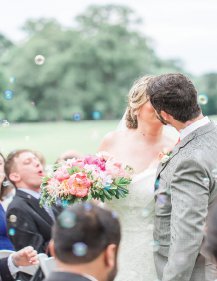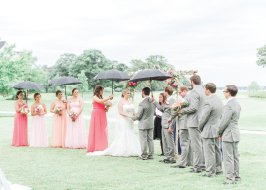× 
Let’s get one thing out of the way from the beginning: whether you’ve attended dozens of weddings or none, your ceremony will be completely different than any other wedding out there. With so many moving parts to a ceremony, no matter what, you’ll find plenty of room to make it your own.
If you have attended ceremonies before, you’ve probably noticed that they all loosely follow the same schedule. We’ll walk you through these traditional events and give you the general gist of how your ceremony will go. That said, it’s completely up to you to individualize it every step of the way.
 PROCESSION
PROCESSION
Proceeding the actual event, you’ll need to make your grand entrance. The wedding party typically enters as well, with the bride entering last. Your officiant should announce your arrival and guests will stand and turn to see you enter. Brides often have their father (or parents) escort them to the altar. You’ll want to set the tone with your choice of music during the procession. Another way to individualize the procession is by including special friends and extended relatives such as your grandparents or children who have a place in your heart.
OPENING
"Dearly beloved, we are gathered here today..." Surely, you’ve heard these words before. The officiant will open the ceremony by welcoming your friends and family. Whoever escorted you down the aisle will take their seat and you and your love will officially be the center of attention. Make eye contact, hold hands, and take a deep breath!
READINGS AND OFFICIANT ADDRESS
Much of this portion of the ceremony will be unique to your religion, your officiant, and your choices as a couple. Traditionally, the officiant will speak on the significance of entering matrimony, the importance of your vows, and share anecdotes on love and marriage. You may also choose to have loved ones share readings to set the tone for your vows. Readings may come from your religious texts, from literature, or even something the reader wrote specifically for you. Some couples have a friend or relative share a song during the ceremony, too.
EXCHANGE OF VOWS AND RINGS
The most important thing you should know is that your vows are meant to be a promise to one another, shared in front of everyone who has had a meaningful part of your lives so far. Even if you plan to write your own vows, it’s a good idea to look over standard vows (“for better or wose, until death do us part”) so you understand what they include. Once you’ve said your vows, you will exchange rings and “be wed.”
If you have attended ceremonies before, you’ve probably noticed that they all loosely follow the same schedule. We’ll walk you through these traditional events and give you the general gist of how your ceremony will go. That said, it’s completely up to you to individualize it every step of the way.

Proceeding the actual event, you’ll need to make your grand entrance. The wedding party typically enters as well, with the bride entering last. Your officiant should announce your arrival and guests will stand and turn to see you enter. Brides often have their father (or parents) escort them to the altar. You’ll want to set the tone with your choice of music during the procession. Another way to individualize the procession is by including special friends and extended relatives such as your grandparents or children who have a place in your heart.
OPENING
"Dearly beloved, we are gathered here today..." Surely, you’ve heard these words before. The officiant will open the ceremony by welcoming your friends and family. Whoever escorted you down the aisle will take their seat and you and your love will officially be the center of attention. Make eye contact, hold hands, and take a deep breath!
READINGS AND OFFICIANT ADDRESS
Much of this portion of the ceremony will be unique to your religion, your officiant, and your choices as a couple. Traditionally, the officiant will speak on the significance of entering matrimony, the importance of your vows, and share anecdotes on love and marriage. You may also choose to have loved ones share readings to set the tone for your vows. Readings may come from your religious texts, from literature, or even something the reader wrote specifically for you. Some couples have a friend or relative share a song during the ceremony, too.
EXCHANGE OF VOWS AND RINGS
The most important thing you should know is that your vows are meant to be a promise to one another, shared in front of everyone who has had a meaningful part of your lives so far. Even if you plan to write your own vows, it’s a good idea to look over standard vows (“for better or wose, until death do us part”) so you understand what they include. Once you’ve said your vows, you will exchange rings and “be wed.”

PRONOUNCEMENT OF MARRIAGE
You aren’t officially married until the officiant pronounces you husband and wife. These words will vary state by state, but they “seal” the ceremony. Then, you get to share your first kiss as newlyweds. Hold that kiss long enough for a good picture!
THE CLOSING AND RECESSIONAL
After the officiant closes the ceremony with a blessing and jubilant words on love and marriage, you will exit the ceremony. This usually happens in the opposite order of your processional and is another opportunity for you to choose music to set the tone for the rest of the event. Typically, your wedding planner will whisk you away so that you are not immediately bombarded by guests as they leave their seats.
 WHAT'S NEXT?
WHAT'S NEXT?
Time to celebrate! Ceremonies vary in length from five minutes to a full hour or even more. You can get married virtually anywhere within the confines of your religious institution. If your ceremony is not at the same location as your reception, you will need to factor in transportation and time to get from place to place.
It’s often easy to get lost in the details of your reception since there are so many decisions to make along the way (food, entertainment, decorations). While the ceremony may seem “easier” to plan, make sure you give it the focus that it deserves. Sit down together and walk through what you envision your ceremony looking like, sounding like, and feeling like. These will be the moments that define the start of your marriage and you have a chance to make it exactly what you’d like.
You aren’t officially married until the officiant pronounces you husband and wife. These words will vary state by state, but they “seal” the ceremony. Then, you get to share your first kiss as newlyweds. Hold that kiss long enough for a good picture!
THE CLOSING AND RECESSIONAL
After the officiant closes the ceremony with a blessing and jubilant words on love and marriage, you will exit the ceremony. This usually happens in the opposite order of your processional and is another opportunity for you to choose music to set the tone for the rest of the event. Typically, your wedding planner will whisk you away so that you are not immediately bombarded by guests as they leave their seats.

Time to celebrate! Ceremonies vary in length from five minutes to a full hour or even more. You can get married virtually anywhere within the confines of your religious institution. If your ceremony is not at the same location as your reception, you will need to factor in transportation and time to get from place to place.
It’s often easy to get lost in the details of your reception since there are so many decisions to make along the way (food, entertainment, decorations). While the ceremony may seem “easier” to plan, make sure you give it the focus that it deserves. Sit down together and walk through what you envision your ceremony looking like, sounding like, and feeling like. These will be the moments that define the start of your marriage and you have a chance to make it exactly what you’d like.